27 July 2019
Things That Shogi Beginner Children Often Get Confused with: #6 Tend Not to Move Gyoku
*Please note that the Kanji numbers in pictures are spelled in English in the text. The following Shogi boards have a face with files (vertical rows) numbered 1 through 9, from right to left, and ranks (horizontal rows) designated with Kanji characters, “一” (One) to “九” (Nine), from top to bottom. On the other hand, in the text, each Kanji character is replaced with an alphabet, from “a” to “i” : “一” with “a”, “二” with “b”, … and “九” with ”i”.
“I Won a Game without Moving Gyoku!”
“I won a game without moving Gyoku (King)!”
I heard this often from a child who won a game. When I first heard this, I was puzzled, and since then I have heard the same words often.
What I observed through a game that children play is that they tend not to move their Gyoku (King) until it gets attacked. A winner often says the above, meaning “I won a game without getting attacked on my Gyoku (King).”
For children who have just started playing Shogi, it must be scary to get attacked on their Gyoku (King). (The same to adults!)
It’s assumable that children are happy to finish a game without getting attacked on their Gyoku (King).
You should value a winner capturing Gyoku (King), or defending against an opponent’s attacks. Not moving Gyoku (King) isn’t a thing that should be appreciated.
The Reason Why Gyoku Shouldn’t Stay on Its Initial Position.
Why do you need to move Gyoku (King)? There are two main reasons for this.
Reason 1: Gyoku sitting on its initial position has fewer spaces to move to.
First, look at the picture below:

Let’s add an opponent’s pieces on the board. It may help you understand what I’m saying.

Blue circles show the squares where Gyoku (King) can move to.
Having Gin (Silver) ahead, the right one only can move sideways. The left can move more, sideways and downward.
Reason 2: Gyoku and Hisha Will Get Attacked Easily at The Same Time.
Move on to the next reason.
The following picture, Picture #1, is the situation often observed in a game played with two beginners. Gote will move a piece next. What is the next move?

It looks Sente is doing well, but Gote can attack Sente’s Gyoku (King) and Hisha (Rook) at the same time: △ B-7g+, ▲S-7g, and △B-1d*, shown in Picture #2. Sente can’t defend against both attacks. After Kei (Knight) on the side of Hisha (Rook) moves, Kaku (Bishop) will move to the square of 3g, which also attacks two pieces at the same time.
The problem here is a position between Gyoku (King) and Hisha (Rook).

Did you understand the risk that you will have when your Gyoku (King) stays on its initial position? Those who know well about standard move sequences might think about the “Fujii System”. There are tactics with which you play a game with your Gyoku (King) staying on its initial position, but I would recommend playing with the tactics after learning the risk of not moving Gyoku (King).
How to Protect Gyoku
I’m sure you understand the risk of not moving Gyoku (King). Now, let’s talk about how to move Gyoku (King) to protect it.
Point 1: Keep Gyoku Away from Hisha
When you move Gyoku (King), move it to the opposite side of Hisha (Rook). In the Ibisha situation, in which Hisha (Rook) stays on its initial right position, move Gyoku (King) to the left. In the Furibisha situation, in which Hisha (Rook) moves to the left over the center, move Gyoku (King) to the right.

Point 2: Build a Castle
Moving Gyoku (King) is not enough to protect it. You need to build a castle which is called Kakoi in Japanese and means protection against attacks for Gyoku (King) with defender pieces.
Boat castles, Mino castles, and Anaguma castles are often used with Ibisha. Mino castles and Anaguma castles are for Furibisha.
Point 3: Choose an Effective Castle for an Ongoing Attack
When you decide which castle you will use, take into consideration how your opponent is attacking. The keynote here is to understand how your defender pieces, Kin (Gold) and Gin (Silver), are connected.
Look at the below picture.

The above picture, Example 1, shows what a Yagura castle looks like. In this castle, two pieces of Kin (Gold) and Gin (Silver) are placed in line behind one another. When pieces are placed vertically, they work well against side attacks. This castle is mainly used when an opponent is using Ibisha.

The next example is a Boat castle, in which two pieces of Kin (Gold) and Gin (Silver) are placed side by side. When defending pieces are placed like this, they are good at side attacks. This castle is used when an opponent is using Furibisha.
You can learn more about tactics and castles with our textbook, “Shogi Lesson Book for Beginners Vol. 3”. Let’s study more with this!

If your child can move Gyoku (King) even though he/she previously kept his/her Gyoku (King) on its initial position, it tells you the child developed skills. Please appreciate their progress.



